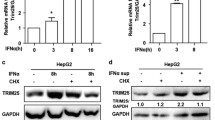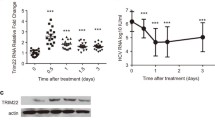Abstract
Type I interferon (IFN) response is central for host defense against viral infection. Tripartite motif 27 (TRIM27) is implicated in antiviral innate immune response; however, whether it affects the replication of hepatitis C virus (HCV) and the underlying mechanisms remain uncharacterized. Here, we show that TRIM27 expression is induced in Huh7.5 human hepatoma cells infected with HCV or stimulated with type I IFNs in vitro. In addition, TRIM27 overexpression increases and its knockdown decreases viral RNA and protein levels, suggesting that TRIM27 positively regulates HCV replication. Mechanistically, TRIM27 inhibits type I IFN response against HCV infection through inhibiting IRF3 and NF-κB pathways, since TRIM27 mutant unable to inhibit these two inflammatory pathways fails to promote HCV replication. Taken together, this study identifies TRIM27 as a novel positive regulator of HCV replication, and also implicates that targeting TRIM27 may serve as a therapeutic strategy for controlling HCV replication.




Similar content being viewed by others
References
Netea, M.G., L.A. Joosten, E. Latz, K.H. Mills, G. Natoli, H.G. Stunnenberg, L.A. O’Neill, and R.J. Xavier. 2016. Trained immunity: a program of innate immune memory in health and disease. Science 352 (6284): aaf1098. https://doi.org/10.1126/science.aaf1098.
Brubaker, S.W., K.S. Bonham, I. Zanoni, and J.C. Kagan. 2015. Innate immune pattern recognition: a cell biological perspective. Annual Review of Immunology 33: 257–290. https://doi.org/10.1146/annurev-immunol-032414-112240.
Reddick, L.E., and N.M. Alto. 2014. Bacteria fighting back: how pathogens target and subvert the host innate immune system. Molecular Cell 54 (2): 321–328. https://doi.org/10.1016/j.molcel.2014.03.010.
Cao, X. 2016. Self-regulation and cross-regulation of pattern-recognition receptor signalling in health and disease. Nature Reviews Immunology 16 (1): 35–50. https://doi.org/10.1038/nri.2015.8.
Kumar, H., T. Kawai, and S. Akira. 2011. Pathogen recognition by the innate immune system. International Reviews of Immunology 30 (1): 16–34. https://doi.org/10.3109/08830185.2010.529976.
Takeuchi, O., and S. Akira. 2010. Pattern recognition receptors and inflammation. Cell 140 (6): 805–820. https://doi.org/10.1016/j.cell.2010.01.022.
Czerkies, M., Z. Korwek, W. Prus, M. Kochanczyk, J. Jaruszewicz-Blonska, K. Tudelska, S. Blonski, M. Kimmel, A.R. Brasier, and T. Lipniacki. 2018. Cell fate in antiviral response arises in the crosstalk of IRF, NF-kappaB and JAK/STAT pathways. Nature Communications 9 (1): 493. https://doi.org/10.1038/s41467-017-02640-8.
McNab, F., K. Mayer-Barber, A. Sher, A. Wack, and A. O’Garra. 2015. Type I interferons in infectious disease. Nature Reviews Immunology 15 (2): 87–103. https://doi.org/10.1038/nri3787.
Gower, E., C. Estes, S. Blach, K. Razavi-Shearer, and H. Razavi. 2014. Global epidemiology and genotype distribution of the hepatitis C virus infection. Journal of Hepatology 61 (1 Suppl): S45–S57. https://doi.org/10.1016/j.jhep.2014.07.027.
AASLD/IDSA HCV Guidance Panel. 2015. Hepatitis C guidance: AASLD-IDSA recommendations for testing, managing, and treating adults infected with hepatitis C virus. Hepatology 62 (3): 932–954. https://doi.org/10.1002/hep.27950.
Saadoun, D., M. Resche Rigon, V. Thibault, M. Longuet, S. Pol, F. Blanc, G. Pialoux, A. Karras, D. Bazin-Karra, C. Cazorla, D. Vittecoq, L. Musset, O. Decaux, J.M. Ziza, O. Lambotte, and P. Cacoub. 2014. Peg-IFNalpha/ribavirin/protease inhibitor combination in hepatitis C virus associated mixed cryoglobulinemia vasculitis: results at week 24. Annals of the Rheumatic Diseases 73 (5): 831–837. https://doi.org/10.1136/annrheumdis-2012-202770.
Scheel, T.K., and C.M. Rice. 2013. Understanding the hepatitis C virus life cycle paves the way for highly effective therapies. Nature Medicine 19 (7): 837–849. https://doi.org/10.1038/nm.3248.
Hatakeyama, S. 2017. TRIM family proteins: roles in autophagy, immunity, and carcinogenesis. Trends in Biochemical Sciences 42 (4): 297–311. https://doi.org/10.1016/j.tibs.2017.01.002.
Zheng, Q., J. Hou, Y. Zhou, Y. Yang, B. Xie, and X. Cao. 2015. Siglec1 suppresses antiviral innate immune response by inducing TBK1 degradation via the ubiquitin ligase TRIM27. Cell Research 25 (10): 1121–1136. https://doi.org/10.1038/cr.2015.108.
Zheng, Q., J. Hou, Y. Zhou, Y. Yang, and X. Cao. 2016. Type I IFN-inducible downregulation of microRNA-27a feedback inhibits antiviral innate response by upregulating Siglec1/TRIM27. Journal of Immunology 196 (3): 1317–1326. https://doi.org/10.4049/jimmunol.1502134.
Wakita, T., T. Pietschmann, T. Kato, T. Date, M. Miyamoto, Z. Zhao, K. Murthy, A. Habermann, H.G. Krausslich, M. Mizokami, R. Bartenschlager, and T.J. Liang. 2005. Production of infectious hepatitis C virus in tissue culture from a cloned viral genome. Nature Medicine 11 (7): 791–796. https://doi.org/10.1038/nm1268.
Lindenbach, B.D., M.J. Evans, A.J. Syder, B. Wolk, T.L. Tellinghuisen, C.C. Liu, T. Maruyama, R.O. Hynes, D.R. Burton, J.A. McKeating, and C.M. Rice. 2005. Complete replication of hepatitis C virus in cell culture. Science 309 (5734): 623–626. https://doi.org/10.1126/science.1114016.
Zhang, H.X., Z.S. Xu, H. Lin, M. Li, T. Xia, K. Cui, S.Y. Wang, Y. Li, H.B. Shu, and Y.Y. Wang. 2018. TRIM27 mediates STAT3 activation at retromer-positive structures to promote colitis and colitis-associated carcinogenesis. Nature Communications 9 (1): 3441. https://doi.org/10.1038/s41467-018-05796-z.
Zhou, Z., X. Jia, Q. Xue, Z. Dou, Y. Ma, Z. Zhao, Z. Jiang, B. He, Q. Jin, and J. Wang. 2014. TRIM14 is a mitochondrial adaptor that facilitates retinoic acid-inducible gene-I-like receptor-mediated innate immune response. Proceedings of the National Academy of Sciences of the United States of America 111 (2): E245–E254. https://doi.org/10.1073/pnas.1316941111.
Ploss, A., M.J. Evans, V.A. Gaysinskaya, M. Panis, H. You, Y.P. de Jong, and C.M. Rice. 2009. Human occludin is a hepatitis C virus entry factor required for infection of mouse cells. Nature 457 (7231): 882–886. https://doi.org/10.1038/nature07684.
Feld, J.J., and J.H. Hoofnagle. 2005. Mechanism of action of interferon and ribavirin in treatment of hepatitis C. Nature 436 (7053): 967–972. https://doi.org/10.1038/nature04082.
Wong, M.T., and S.S. Chen. 2016. Emerging roles of interferon-stimulated genes in the innate immune response to hepatitis C virus infection. Cellular & Molecular Immunology 13 (1): 11–35. https://doi.org/10.1038/cmi.2014.127.
Bartenschlager, R., F. Penin, V. Lohmann, and P. Andre. 2011. Assembly of infectious hepatitis C virus particles. Trends in Microbiology 19 (2): 95–103. https://doi.org/10.1016/j.tim.2010.11.005.
Marcello, T., A. Grakoui, G. Barba-Spaeth, E.S. Machlin, S.V. Kotenko, M.R. MacDonald, and C.M. Rice. 2006. Interferons alpha and lambda inhibit hepatitis C virus replication with distinct signal transduction and gene regulation kinetics. Gastroenterology 131 (6): 1887–1898. https://doi.org/10.1053/j.gastro.2006.09.052.
Jiang, Z., T.W. Mak, G. Sen, and X. Li. 2004. Toll-like receptor 3-mediated activation of NF-kappaB and IRF3 diverges at Toll-IL-1 receptor domain-containing adapter inducing IFN-beta. Proceedings of the National Academy of Sciences of the United States of America 101 (10): 3533–3538. https://doi.org/10.1073/pnas.0308496101.
Kawai, T., and S. Akira. 2007. Signaling to NF-kappaB by Toll-like receptors. Trends in Molecular Medicine 13 (11): 460–469. https://doi.org/10.1016/j.molmed.2007.09.002.
Conwell, S.E., A.E. White, J.W. Harper, and D.M. Knipe. 2015. Identification of TRIM27 as a novel degradation target of herpes simplex virus 1 ICP0. Journal of Virology 89 (1): 220–229. https://doi.org/10.1128/JVI.02635-14.
Wang, J., J.L. Teng, D. Zhao, P. Ge, B. Li, P.C. Woo, and C.H. Liu. 2016. The ubiquitin ligase TRIM27 functions as a host restriction factor antagonized by Mycobacterium tuberculosis PtpA during mycobacterial infection. Scientific Reports 6: 34827. https://doi.org/10.1038/srep34827.
Chen, Y., S. Wang, Z. Yi, H. Tian, R. Aliyari, Y. Li, G. Chen, P. Liu, J. Zhong, X. Chen, P. Du, L. Su, F.X. Qin, H. Deng, and G. Cheng. 2014. Interferon-inducible cholesterol-25-hydroxylase inhibits hepatitis C virus replication via distinct mechanisms. Scientific Reports 4: 7242. https://doi.org/10.1038/srep07242.
Nisole, S., J.P. Stoye, and A. Saib. 2005. TRIM family proteins: retroviral restriction and antiviral defence. Nature Reviews Microbiology 3 (10): 799–808. https://doi.org/10.1038/nrmicro1248.
Taylor, R.T., K.J. Lubick, S.J. Robertson, J.P. Broughton, M.E. Bloom, W.A. Bresnahan, and S.M. Best. 2011. TRIM79alpha, an interferon-stimulated gene product, restricts tick-borne encephalitis virus replication by degrading the viral RNA polymerase. Cell Host & Microbe 10 (3): 185–196. https://doi.org/10.1016/j.chom.2011.08.004.
Asaoka, K., K. Ikeda, T. Hishinuma, K. Horie-Inoue, S. Takeda, and S. Inoue. 2005. A retrovirus restriction factor TRIM5alpha is transcriptionally regulated by interferons. Biochemical and Biophysical Research Communications 338 (4): 1950–1956. https://doi.org/10.1016/j.bbrc.2005.10.173.
Wang, S., Y. Chen, C. Li, Y. Wu, L. Guo, C. Peng, Y. Huang, G. Cheng, and F.X. Qin. 2016. TRIM14 inhibits hepatitis C virus infection by SPRY domain-dependent targeted degradation of the viral NS5A protein. Scientific Reports 6: 32336. https://doi.org/10.1038/srep32336.
Author information
Authors and Affiliations
Corresponding author
Ethics declarations
All experimental protocols were approved by the Ethics Committee of Qilu Hospital of Shandong University.
Conflict of Interest
The authors declare that they have no conflict of interest.
Additional information
Publisher’s Note
Springer Nature remains neutral with regard to jurisdictional claims in published maps and institutional affiliations.
Rights and permissions
About this article
Cite this article
Zheng, F., Xu, N. & Zhang, Y. TRIM27 Promotes Hepatitis C Virus Replication by Suppressing Type I Interferon Response. Inflammation 42, 1317–1325 (2019). https://doi.org/10.1007/s10753-019-00992-5
Published:
Issue Date:
DOI: https://doi.org/10.1007/s10753-019-00992-5




